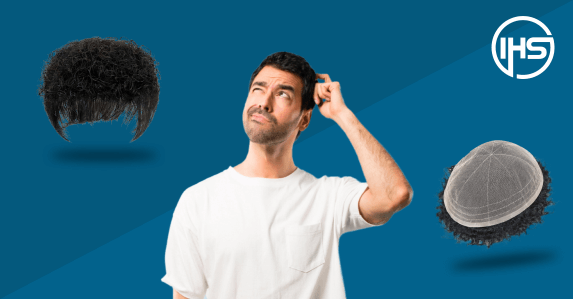



Contact our specialists now for Hair Replacement!
Knock-knock decision time! Hair toppers vs wigs- what is ideal for me? One covers a little, and the other covers it all. But choosing between the two is not as easy as it sounds.
Don’t worry, we have got your back (or, in this case, your head). If you want something that blends with your hair or goes full glam, we’ll walk you through it all. Either way, it’s all about finding what makes you feel good.
Spoiler – Both hair replacement systems work the best. But who can be the real winner? The one that works for you. Stick around, and let us take you through the pros, cons, and everything in between.
Right then-no confusion, just the facts.
So, let us dive in because hair is a statement of style, an affirmation of beauty, and an expression of self-love!
Wigs are hairpieces typically made for the entire scalp. They can be made of synthetic fibres, human hair, or a combination of both and come in a wide range of styles, lengths, and colours.
A little etymology. Did you know that the term “wig” finds its roots in the French word (per)ruque? Initially crafted from a variety of materials, including horsehair, human hair, wool, feathers, buffalo hair, or even synthetics.
Wigs were more than just a fashion statement- they were practical solutions to lots of hair-related challenges.
A hair topper is a versatile hairpiece made specifically to adjust smoothly with natural hair. It provides volume and partial coverage to only those areas that are experiencing thinning hair, bald spots, or hair loss.
Whereas hair toppers go by various names such as wiglets, half wigs, and hairpieces, etc.
Hair toppers are not one size fits all, and they come in various sizes to deal with different needs and areas of hair loss. Here’s a breakdown of different sizes.
Base dimension |
Suitability |
Coverage |
|---|---|---|
|
2" x 5" |
It is ideal for early stages of hair loss. |
Covers parting line & crown areas. |
|
3" x 3.5" |
It is ideal for minor thinning at the front. |
Covers the crown and parting line, the top of the scalp, and frontal areas (partially). |
|
1.5" x 5" |
Suitable for mild hair loss on the top of the scalp |
It covers part line thinning, mild crown thinning & early stage hair loss. |
Base dimension |
Suitability |
Coverage |
|---|---|---|
|
2" x 6" |
A good choice for moderate thinning. |
It will cover the parting line & the small section of the crown |
|
6" x 6" |
Good for more noticeable hair loss. |
It will cover the crown area on top of the scalp & give partial coverage of the front hairline |
|
6" x 7" |
It is an ideal choice for advanced hair thinning or hair loss. |
It will cover the crown area on top of the scalp &front hairline & mid-scalp areas. |
Base dimension |
Suitability |
Coverage |
|---|---|---|
|
7" x 8" |
Great choice for more extensive areas of thinning |
It covers the crown area, top of the scalp area, frontal area & mid-scalp area. |
|
8" x 9" |
Best suitable for advanced hair loss |
It covers the crown area, top of the scalp area, frontal area, mid-scalp area & upper nape. |
|
9" x 9" |
It is ideal for advanced hair loss & diffuse thinning. |
It covers the crown area, top of the scalp area, frontal area, mid-scalp area, upper nape & sides. |
Take a flexible measuring tape and measure side to side up until the point where your head starts to curve.
Then measure from front to back, starting from your hairline to where the back of your head starts to curve back.
Tip : Make sure you have enough hair for clips to snap in that area for each measurement step. If hair is sparse, increase the measurement (move the tape down) until you reach areas with natural hair.
Monofilament is one type of material in which the hair strands are sewn.
Monofilament material is thin, gauze-like, and nearly transparent, which is why it is much more comfortable to wear and touch.
100% hand knotted, or 100% hand-tied, will let each hair pass freely for the most natural look.
In addition, the other designs known as ‘hand-tied’ significantly feature a combination of hand-tied and machine-attached hair.
This construction states that some areas (generally the part or crown) are hand-tied, but the rest are machine-attached.
A wefted cap, also known as a wefted wig or machine-made wig, is a type of topper construction in which hair is sewn onto a base or cap using a sewing machine.
Next, the hair that is being used in the wefted cap topper is usually attached to the cap in rows or wefts, which are sewn closely together.
Each hair strand is hand-tied into a thin, breathable mesh in a monofilament cap.
This will make it look like the hair is growing directly from your scalp, offering that natural appearance along the part line.
This cap construction is soft and breathable, ideal for sensitive scalps.
A lace cap is made from delicate lace material. Hair is hand-tied to the lace and used at the front to create an invisible hairline.
The lace blends smoothly with the scalp, making it hard to tell where your hair ends and the topper begins.
The silk base cap will have a layer of silk that brilliantly hides the hair knots underneath, giving the appearance of hair coming from your scalp. It looks ultra-realistic, even under close inspection. Perfect for a polished, professional finish.
At the same time, it is smooth against the scalp but a bit thicker than lace.
Polyurethane is a very skin-like material used alongside edges to hold tapes or glue in place properly.
This base is also waterproof and long-lasting, which is best for individuals who want a hair system that stays put throughout the day.
Swiss lace is ultra-thin and perfect for warm weather or all-day wear. It’s also nearly invisible, creating a flawless blend with your natural hairline. This is best for toppers with medium to high wig density, where realism is important.
French lace is a bit sturdier than Swiss lace but provides a natural look. It becomes easy to identify the best hair system with French lace due to its breathable & natural look.
Hair toppers can stay in place utilising several ways. Let us see which are those ways,
This is probably one of the most common ways to attach a topper. All you have to do is open the clips, slide the comb-like “teeth” of clips into your hair, and press them closed.
PRO Tip : Always make sure your topper base is the perfect size to cover hair loss easily and attach to hair thick enough to support the clips.
There are toppers with bases available that will allow you to use double-sided tape for that secured fit.
Most toppers have a polyurethane (or “PU”) perimeter where you can use the tape.
You can also use lace front tape on lace front toppers. A tape for nearly every topper base design ensures the best hold according to the material.
Liquid adhesives can also be used for bonding.
A hypoallergic & roll-on liquid will offer hold, which can be detached and washed out with water at the end of the day.
The answer is that it entirely depends upon your preferences and needs! It is essential that you first decide what you want.
Here is the straightaway comparison to give you a quick decision: Wigs cover the entire scalp and are considered for those suffering from advanced hair loss. Famous celebrities use them widely to enhance their overall appeal while concealing hair loss.
On the other hand, toppers are used to cover hair loss in a particular area by offering limited coverage. So, choose what you think is best for you.
You can wear hair toppers if,
If you’re experiencing thinning hair or hair loss in specific areas of your head, hair toppers are the best option. They clip onto your existing hair and provide decent coverage. The toppers will blend well enough with your natural hairline to give you that natural look!
You can wear wigs if,
Wigs come down with a complete hair loss solution for anyone experiencing advanced hair loss.
Men’s wigs are different from hair toppers in that they are designed to blend with existing hair, while wigs cover the entire scalp.
This makes wigs the perfect choice for individuals who have lost their hair due to medical conditions like alopecia, chemotherapy, or genetic factors.
In the never-ending discussion of hair toppers versus wigs, the best choice ultimately depends upon your needs, lifestyle, and preferences.
Go with hair toppers if you need a little lift or switch to hair wigs if you are looking for a completely new look & feel, it is as simple as doing what you want & how – And then you can head over to IHS London for expert guidance and find your perfect match!

IHS Hair Replacement is a hair replacement brand based in 2 prime locations, West Kensington in West London and Liverpool Street in Central London. We provide a full head of hair achieved through our hair integration procedure giving you confidence and life.